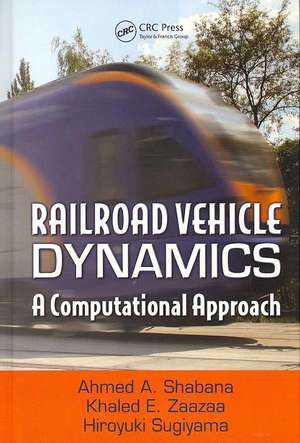Railroad Vehicle Dynamics: A Computational Approach
Autor Ahmed A. Shabana, Khaled E. Zaazaa, Hiroyuki Sugiyamaen Limba Engleză Hardback – 23 iul 2007
Railroad Vehicle Dynamics: A Computational Approach presents a computational multibody-system approach that can be used to develop complex models of railroad vehicle systems. The book examines several computational multibody-system formulations and discusses their computer implementation. The computational algorithms based on these general formulations can be used to develop general- and special-purpose railroad vehicle computer programs for use in the analysis of railroad vehicle systems, including the study of derailment and accident scenarios, design issues, and performance evaluation.
The authors focus on the development of fully nonlinear formulations, supported by an explanation of the limitations of the linearized formulations that are frequently used in the analysis of railroad vehicle systems. The chapters of the book are organized to guide readers from basic concepts and definitions through a final understanding of the utility of fully nonlinear multibody- system formulations in the analysis of railroad vehicle systems.
Railroad Vehicle Dynamics: A Computational Approach is a valuable reference for researchers and practicing engineers who commonly use general-purpose, multibody-system computer programs in the analysis, design, and performance evaluation of railroad vehicle systems.
Preț: 1060.49 lei
Preț vechi: 1452.41 lei
-27% Nou
Puncte Express: 1591
Preț estimativ în valută:
202.93€ • 212.30$ • 168.57£
202.93€ • 212.30$ • 168.57£
Carte tipărită la comandă
Livrare economică 02-16 aprilie
Preluare comenzi: 021 569.72.76
Specificații
ISBN-13: 9781420045819
ISBN-10: 1420045814
Pagini: 360
Ilustrații: 715 equations; 23 Tables, black and white; 117 Illustrations, black and white
Dimensiuni: 156 x 234 x 29 mm
Greutate: 1.45 kg
Ediția:1
Editura: CRC Press
Colecția CRC Press
ISBN-10: 1420045814
Pagini: 360
Ilustrații: 715 equations; 23 Tables, black and white; 117 Illustrations, black and white
Dimensiuni: 156 x 234 x 29 mm
Greutate: 1.45 kg
Ediția:1
Editura: CRC Press
Colecția CRC Press
Public țintă
ProfessionalCuprins
Introduction. Dynamic Formulations. Rail and Wheel Geometry. Contact and Creep-Force Models. Multibody Contact Formulations. Implementation and Special Elements. Specialized Railroad Vehicle Formulations. Creepage Linearization. Appendices. References. Index.
Recenzii
"The book is designed as an introductory course on railroad vehicle dynamics that is suitable for senior undergraduate and first-year graduate students. It can also be used as a reference book by researchers and practicing engineers who commonly use general-purpose multibody system computer programs in the analysis, design, and performance evaluation of railroad vehicle systems." - Bojidar Cheshankov, Zentralblatt MATH, 2008, Vol. 1133
"It is a heavily mathematical treatise on how railway vehicles move as they travel down the track . . . suitable for use by advanced undergraduate and beginning graduate students interested in railway dynamics."
– In Books-On-Line, November, 2008
"It is a heavily mathematical treatise on how railway vehicles move as they travel down the track . . . suitable for use by advanced undergraduate and beginning graduate students interested in railway dynamics."
– In Books-On-Line, November, 2008
Notă biografică
Ahmed A. Shabana, Khaled E. Zaazaa, Hiroyuki Sugiyama
Descriere
Computational multibody system approaches have been extensively used in modeling many physical systems. Railroad Vehicle Dynamics: A Computational Approach presents computational multibody system formulations that can be used to develop computer models for complex railroad vehicle systems. Focusing on nonlinear formulations, this book explains the limitations of linearized formulations that are frequently used in analysis. Vehicle/rail interaction, a distinguishing feature of railroad vehicle systems, requires a special force or kinematic element to be included in multibody system algorithms. Using this approach, the authors address and solve geometric problems that are specific to railroad vehicle systems.










